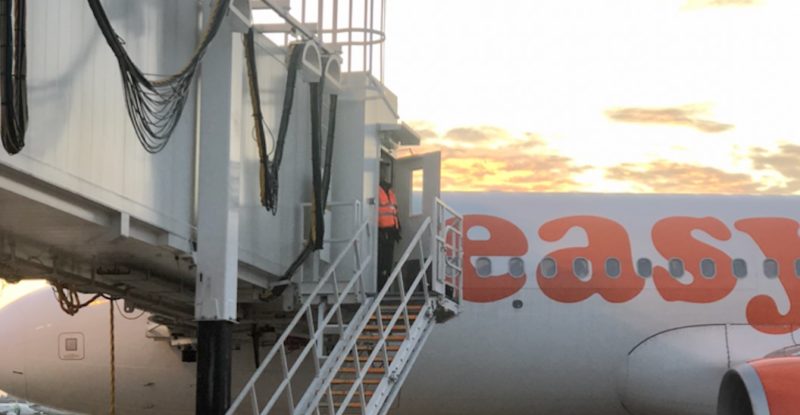 Today, five European flights will converge on Lyon Airport, applying innovative technologies, fuels and air navigation procedures to minimise their carbon emissions, thus showing the potential to transform the environmental impact of the aviation industry.
Today, five European flights will converge on Lyon Airport, applying innovative technologies, fuels and air navigation procedures to minimise their carbon emissions, thus showing the potential to transform the environmental impact of the aviation industry.
The flights – from Amsterdam, Barcelona, Bucharest, Frankfurt and Lisbon – are arriving this afternoon on the occasion of the European Commission’s ‘Connecting Europe Days’ event using the following measures:
- Environmentally-optimised routings – By taking advantage of airspace normally reserved for the military and by using improved vertical and lateral profiles, new, more direct routings are made possible, improving trajectories and descents into Lyon Airport’s approach airspace. In this way, the five flights are achieving a more optimal trajectory for minimising fuel burn and thus reducing emissions. These are made possible thanks to collaboration between EUROCONTROL, the air navigation service providers from eleven countries1 and the respective National Military Authorities, in partnership with the ALBATROSS project.2
- Sustainable aviation fuels (SAFs) –Airlines including Air France, easyJet, KLM, Lufthansa, Transavia and Vueling are each uplifting 30 per cent SAF on a total of ten flights departing from Lyon, resulting in a CO2 emissions reduction of 27 per cent per flight compared to conventional fuel use. Increased SAF uptake has been proven to be the most effective means to decarbonise aviation in the next decades until newer technologies, such as hydrogen, become available.
- Carbon neutral airport operations and infrastructure – Lyon Airport is deploying the most energy-efficient operational know-how and solutions for turnaround of these aircraft. The host airport is an exemplary part of VINCI Airports’ environmental strategy, having already achieved carbon neutrality with compensation in 2017 within Airport Carbon Accreditation. It is now on course to become the first commercial airport in France to reach net zero CO2 emissions by 2026 within the scope of its business. Lyon Airport is also a pilot for VINCI Airports’ plan to kickstart hydrogen use at airports to accommodate hydrogen-powered aircraft as early as 2023, in partnership with Airbus and Air Liquide.
This co-ordinated action has shown what can be achieved through the application of measures set out in the Destination 2050 Roadmap,3 an initiative of the five leading European aviation associations4 to identify a pathway for their sector to reach the EU’s climate goal of net zero carbon emissions by 2050. The European aviation industry is committed to this roadmap, but in order to make today’s exceptional measures possible on a wider basis, they call for political support for its four pillars, including:
Aircraft and engine technologies
- New technologies are expected to enter the market in the 2030s. To make this happen, Technology Readiness Level (TRL) is needed by 2027–2030 and efficient certification procedures are required. At the same time, the further enhancement of existing technologies should not be neglected as they still have vast potential to contribute to the drastic reduction of aviation emissions. So far, each new generation of aircraft is on average 20 per cent more fuel efficient than its predecessors.
- Full support for funding programmes at EU level (via the Clean Aviation Joint Undertaking) and Member State level is needed to stimulate further development and deployment of new technologies.
- Support industry via incentives and de-risking investments.
Air traffic management and aircraft operations
- Full support for research under the EU’s SESAR 3 Joint Undertaking on new technologies and procedures is needed to enable the transition to more sustainable and efficient skies.
- National governments to fully implement the Single European Sky, for example by supporting the roll-out of measures such as cross-border free route airspace (allowing aircraft to freely plan a more direct route between defined entry and exit points) and flexible use of airspace (enabling a switch from military to civilian use at short notice).
SAFs
- Sustainable aviation fuels (SAFs) represent one of the most promising solutions to decarbonise aviation, however production is still very low, and prices are too high.
- Incentives are necessary to incentivise production and bridge the price gap between SAFs and conventional jet fuel.
- An EU blending mandate offers the necessary policy framework to increase production and uptake of SAF.
Smart economic measures
- Economic measures will be critical in the short term until the sector can start relying on SAFs and new technologies (circa 2030s).
- An ambitious global measure, such as CORSIA, is necessary. Aviation is by its nature a global industry; therefore, it needs one single emissions trading/offsetting scheme to avoid carbon leakage and double counting of emissions.
With the necessary political support and the right legislative framework, our members can take the required steps to achieve the EU’s net zero carbon emissions target by 2050.
1 Belgium (skeyes), Croatia (Croatia Control), France (DSNA), Germany (DFS), Italy (ENAV), the Netherlands (LVNL), Portugal (NAV Portugal), Romania (ROMATSA), Serbia (SMATSA), Spain (ENAIRE) and Switzerland (skyguide).
2 https://www.dlr.de/ft/en/
3 https://www.destination2050.
4 A4E, ACI EUROPE, ASD Europe, CANSO, ERA.
Notes to editor:
Flights on 28 June include: EasyJet: Flights EJU4434 from Lisbon to Lyon; Lyon to Gatwick and Lyon to Toulouse; Lufthansa:Flight LH1076 from Frankfurt to Lyon and flight LH1077 from Lyon to Frankfurt; Air France flights AF1594 from Lyon to Brest and AF1574 from Lyon to Pau; KLM flight KL1415 from Amsterdam to Lyon, flights KL1416 and KL1418 from Lyon to Amsterdam; Transavia flight TO7770 from Lyon to Porto; Vueling flight VY1220 from Barcelona to Lyon and flight VY1221 from Lyon to Barcelona. See also Connecting Europe by Air programme for more information.
About Destination 2050
Europe’s aviation sector is collectively on board to lead the way in reducing aviation CO2 emissions by 2030 and 2050 – making flying more sustainable for the long term. In February 2021, Europe’s airlines, airports, aerospace manufacturers and air navigation service providers laid out a joint long-term vision along with concrete solutions to the complex challenge of reaching net zero CO2 emissions from all flights departing the EU, UK and EFTA by 2050. The independent report by the Royal Netherlands Aerospace Centre (NLR) and SEO Amsterdam Economics shows how a combination of actions from all stakeholders – including the EU and national governments – in four key areas could achieve substantial CO2 emissions reductions in line with EU climate goals. These include: improvements in aircraft and engine technologies (including hybrid, electric and hydrogen propulsion), using sustainable aviation fuels (SAFs) both for fixed- and rotary-wing platforms, implementing economic measures and improvements in air traffic management (ATM) and aircraft operations.










